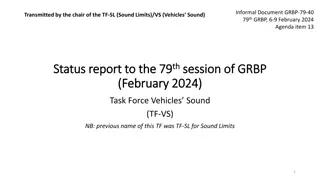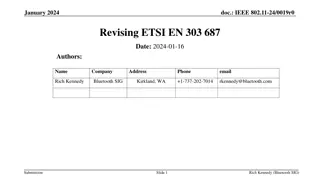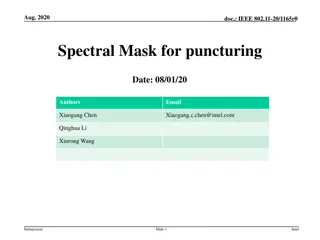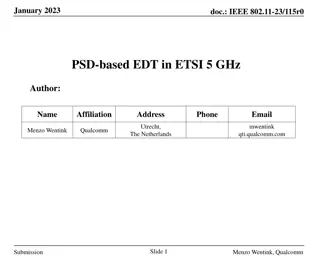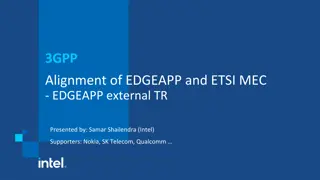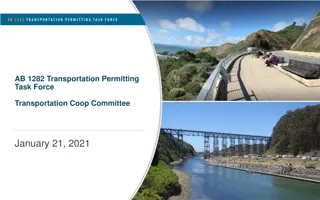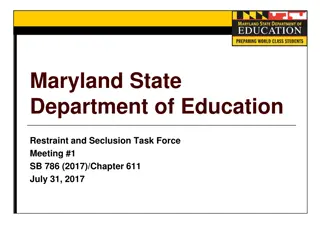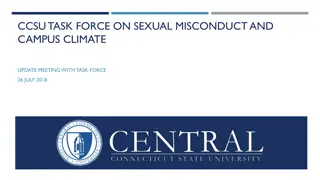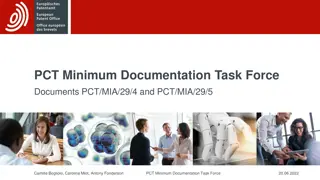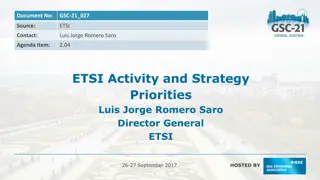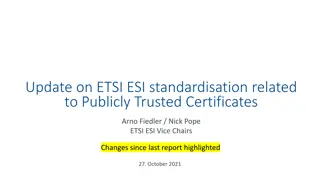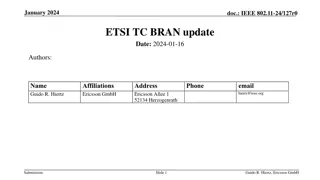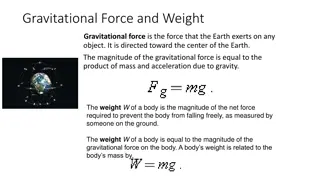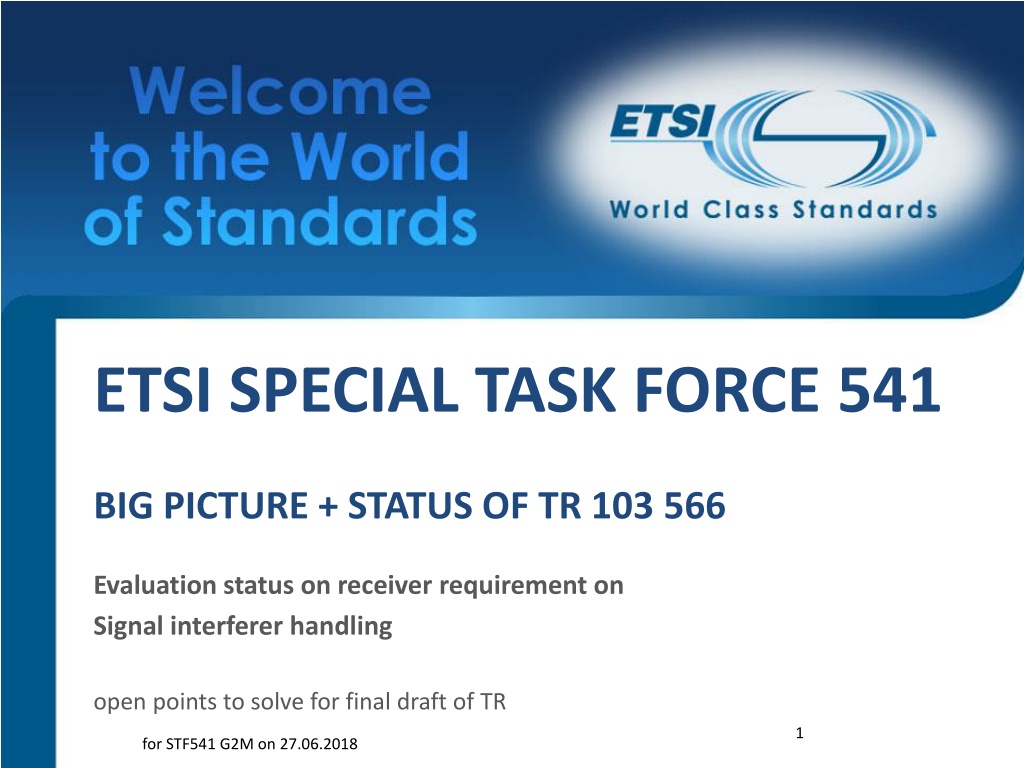
ETSI Special Task Force 541: Summary & Evaluation Status
Explore the progress and evaluation status of ETSI Special Task Force 541 regarding receiver requirements and Signal Interferer Handling. Discover insights into harmonized standards, EU law implications, and input from the EC on performance criteria for conformity. Stay informed on the latest developments for TR.103.566 and the big picture for STF541.
Download Presentation

Please find below an Image/Link to download the presentation.
The content on the website is provided AS IS for your information and personal use only. It may not be sold, licensed, or shared on other websites without obtaining consent from the author. Download presentation by click this link. If you encounter any issues during the download, it is possible that the publisher has removed the file from their server.
E N D
Presentation Transcript
ETSI SPECIAL TASK FORCE 541 BIG PICTURE + STATUS OF TR 103 566 Evaluation status on receiver requirement on Signal interferer handling open points to solve for final draft of TR 1 for STF541 G2M on 27.06.2018
Judgement Case C-613/14 check backup slides on Case C-613/14 for more details (40) It follows from the above that a harmonised standard such as that at issue in the main proceedings, adopted on the basis of Directive 89/106 and the references to which have been published in the Official Journal of the European Union, forms part of EU law, since it is by reference to the provisions of such a standard that it is established whether or not the presumption laid down in Article 4(2) of Directive 89/106 applies to a given product. source : http://curia.europa.eu/juris/document/document.jsf;jsessionid=9ea7d0f130da11f9008c43f54a9091c3ec7d0fb000a3.e34KaxiL c3eQc40LaxqMbN4Pb3mLe0?text=&docid=184891&pageIndex=0&doclang=en&mode=lst&dir=&occ=first&part=1&cid=806752
Input from EC (1/2) Review of published harmonised standards with severe flaws discovered after publication The Commission mentioned that in the preassessment of EN 305 550 in September 2017 (Ares(2017)4541404), following a similar request in the pre-assessment of EN 302 065-5 in August 2017 (Ares(2017)4012591), it was asked to review at least 6 OJ-published harmonized (this are our six TG UWB EN) standards where the severe problems (self-establishment of requirements and tests) were identified. source: OCG RED EMCD (18)069007
Input from EC (2/2) Performance criteria (...) in order to provide presumption of conformity, should provide precise technical specifications and tests. Failing this, the presumption of conformity cannot be claimed. (...) In such cases the function of the equipment has to be used to observe whether the communications link is being impaired by an interfering signal. (...) One mentioned example was the use of different classes with different technical specifications and test methods which could be used at the choice of the manufacturer, provided that they are defined precisely. the EN shall be clear and more product, use-case specific The Commission also announced that they would investigate the wording "intended use as declared by the manufacturer" with respect to "intended use" only, since a significant legal difference may occur between the two text. source: OCG RED EMCD (18)069007
Input from EC overview 06/2018 check backup slides Inputs from EC for more details Provision of a Harmonised Standard check list, link: OCGREDEMCD(18)068016 Guide to the Radio Equipment Directive 2014/53/EU updated version on 05.06.2018 Declaration by manufacturer : in HENs only intended use , but no declarations allowed. EC wants to see an explanation of how the alternative parameters give an equivalent level of protection. CEPT/ECO conformed that SE21 were working on an ECC Report (maybe an ECC Recommendation) on parameters to be used in compatibility studies which was expected to complete at the end of 2019 Provide precise technical specifications and tests. Failing this, the presumption of conformity cannot be claimed. For any missing [edit: classical conventional] receiver parameter, a justification may be asked and discussed with the stakeholders in the TCAM WG, RSC and/or ADCO RED. [comment: for keeping HEN legally correct] Introduction of Harmonised Standards Technical Consultant (HASTAC) [for all Directives incl. RE-D].
The role of unwanted emissions and receiver performance in spectrum management Spectrum engineering has a role in ensuring that different systems can coexist in a spectrum efficient way without causing harmful interference to each other. In particular, sharing and compatibility studies are important ways to assess that role. (..) receivers also need to ensure they have sufficient filtering (selectivity) to reject interfering signals from neighbouring users. (..) ensure requirements, including receiver parameters, are sufficient to provide protection from interference. Source: ECC Newsletter May 2018 https://www.cept.org/ecc/news/ecc-newsletter-may-2018/
STF494 TS 103 361 Information on Performance Criteria ANNEX A.2 Sensor devices While the performance of communication devices in most cases may be defined by a Bit Error Rate (BER) for a given range/protocol, most sensor devices are proprietary since they typically do not need to comply with certain standards / protocols. In addition the main purpose of a sensor is to sense certain physical parameters and to process the physical data into some form of application related parameter like distance, position, breath rate, fluidi level, etc. The performance of a sensor device is thus a combination of the electrical/physical quality of the sensor and the signal processing required extracting the required information. As a consequence it is very hard to specify a well-defined performance criterion covering all sensor devices. Therefore it is suggested using a manufacturer defined performance level. A similar approach is used for example in IEC 61000-4-3 EMC immunity. Examples for manufacturer defined performance levels: BMA: The device detects a certain object in a defined depth within a specific wall. TLPR: The device measures a certain surface in a defined distance with a specific accuracy. Protection from interference of new receiver parameter not provided (yet)
Status TG UWB after #45 (20.06.2018) TG UWB creates NWIs for each regulation to make sub-parts keeping name and adding a sub-number for use cases (intended use cases) and if necessary for RX requirements differ in use cases, add device classes in each sub-parts NWI for EN 302 372 ERMTGUWB(18)045026r1 Tank Level Probing Radar (TLPR) NWI for EN 302 729 ERMTGUWB(18)045027 Level Probing Radar (LPR) NWI for EN 302 065-4-1 ERMTGUWB(18)045025 Material Sensing devices NWI for EN 302 065-3-1 ERMTGUWB(18)045024 devices for ground based vehicular applications NWI for EN 302 065-2-1 ERMTGUWB(18)045022r1 location tracking NWI for EN 302 065-2-2 ERMTGUWB(18)045023 location tracking NWI for EN 302 065-1-3 ERMTGUWB(18)045021 Generic UWB applications For handling reasons of the sub-parts, the device classes may require sub-sub-parts. NWI for EN 302 065-1-2 ERMTGUWB(18)045020 Generic UWB applications NWI for EN 302 065-1-1 ERMTGUWB(18)045019 Generic UWB applications NWI for EN 303 883-2 Short Range Devices (SRD) using Ultra Wide Band (UWB); Measurement Techniques ERMTGUWB(18)045018 Next step: Create a survey form to get the intended use cases and if necessary the device classes. NWI for EN 303 883-1 Short Range Devices (SRD) using Ultra Wide Band (UWB); Measurement Techniques ERMTGUWB(18)045017
EC point of view: Risks identified EC wants precise tests with limits, no options, no declarations Industry aims to a lot of different use cases Risks: use case depended standartisation will produce a lot of effort, pushed 25 years back to type approval. Therefore, use cases with small to medium product volumes will be too expensive and will not occur on market. SMEs1 faces a too high effort to overcome for market entry, blocked standards close non-EU markets referencing conformity assessments to these standards This will stop innovations and weakens SMEs1 1 SME Small Medium Enterprises
Draft Results Deliverable TR 103 566 Title of TR: Evaluation status on receiver requirement on Signal interferer handling TR Draft Results will cover: Definition of min necessary requirements (e.g. intended use, receiver requirements, performance criteria, interfering power, frequency range, ) Classical RX parameters, Evaluation RX test implemented in HEN Summary of new/additional systems / equipment which could use the new concept Evaluation current RX test implemented in HEN which could fall under this new concept Relation between traditional RX-parameters and new concept STF541 presentation, STF open work session February 2018 10
Definition of min necessary requirements (1/2) Intended Use in respect to RE-D only on RX in presence of interferer is the focus of STF: RX parameter of new concepts are leading to discussion about intended use of device and radio part performance criteria of device and radio part example mower: device: mow!, RX: detect the boundary signal Example Wall scanner [Bosch D-tect 150 SV]: The measuring tool is intended for detecting objects in walls, ceilings and floors. Depending on material and condition of the structural surface, metal objects, wooden beams, plastic pipes, wiring and cables can be detected. For objects detected, the object depth to the surface of the object is determined. Example Electric Toothbrush with Bluetooth interface: [Braun Oral-B GENIUS 8000] Use this product only for its intended use as described in this manual. STF541 presentation, STF open work session February 2018 11
Definition of min necessary requirements (2/2) Impact of protocol and error correction on spectrum efficiency and receiver requirements have to be taken into account. Radio equipment should minimize the amount of bandwidth and media access time and TX power required to achieve its intended level of performance in its defined mode of operation. Categories of problem are use scenario dependent, not accessible paramterers in RX, shared spectrum Intention is efficient use of spectrum STF541 presentation, STF open work session February 2018 12
Classical Receiver Parameters (1/2) Receiver sensitivity Receiver co-channel rejection Receiver Selectivity Receiver adjacent signal selectivity (adjacent channel selectivity) Receiver spurious response rejection Receiver blocking Receiver radio-frequency intermodulation Receiver dynamic range Reciprocal mixing Desensitization Receiver unwanted emissions in the spurious domain STF541 presentation, Workshop June 2018 13
Classical Receiver Parameters (2/2) Simplified definitions based on the ETSI Guide are included in the TR Investigations on measurements relating to some classical parameters were performed: Clear definitions allows to identify where limits are applicable (co-channel, adjacent channel, spurious emissions domain...) Access to test points to assess the conformity of the system with the limits given in the standards (transmitted power) Access to test points to inject interfering signal to assess the performance of the system while receiving an interfering power Access to test points to assess the performance of a system while receiving an interfering power STF541 presentation, Workshop June 2018 14
Evaluation RX test implemented in HEN (1/2) Example: Co-channel "external" and adjacent channel interference sensitivity EN 302 217-2-2 V2.1.1 specifies: The co-channel "external" interference is considered to be that given by a like signal completely uncorrelated with the one under test. There are different requirements for "internal" interference given by the cross polar transmitters in systems implementing XPIC for CCDP operation; however, the latter requirements are not considered relevant to essential requirements under article 3.2 of R&TTE Directive [1] and are set out in EN 302 217-2-1 [i.27]. The limits of Carrier to Interference ratio (C/I) in case of co-channel and adjacent channel interference shall be as specified in the relevant tables of annexes A to E and Ea, giving maximum C/I values for 1 dB and 3 dB degradation of the RSL limits declared by the supplier for a BER 10-6in clause 4.3.2. For adjacent channel interference, the requirement shall be met independently on upper and lower adjacent interference. STF541 presentation, STF open work session February 2018 15
Evaluation RX test implemented in HEN (2/2) Example: CW spurious interference EN 302 217-2-2 V2.1.1 [ref] was published in 2013 and already contained a section dealing with Essential radio test suites for the receiver as described in the following sections. This section considers the test to be performed for the CW spurious interference. EN 302 217-2-2 V2.1.1 [ref] specifies: For a receiver operating at the RSL declared by the supplier in clause 4.3.2 for a BER 10-6 threshold, the introduction of a CW interferer at a level specified by EN 301 390, but not exceeding the maximum upper RSL limit for BER = 10^-6 defined in EN 302 217-2-1 [i.27] clause 6.4.1, with respect to the wanted signal and at any frequency up to the relevant upper and lower frequency limits derived from the table set out in clause 7.1 of EN 301 390 [5], but excluding frequencies either side of the wanted frequency by up to 250 % of the separation between channels using the same polarization, shall not result in a BER greater than 10-5. RSL: Received Signal Level STF541 presentation, STF open work session February 2018 16
Tests for Classical RX Classical RX, three main categories: 1. Co-frequency/Co-Channel phenomena: Sensitivity, Selectivity, Receiver co-channel rejection 2. Adjacent & Nearby frequencies phenomena: Selectivity, Adjacent signal selectivity, blocking 3. Far away phenomena: Selectivity (?), Blocking, Receiver spurious response rejection Do we need to have similar approaches/concepts for non classical receivers? Transmitter 1 vs Receiver 2 offset Blocking2 Tx1 Tx ACS2 OOB1 Rx2 Spurious1
New/additional systems / equipment Definition: Devices are highly integrated, no test points available, no classical RX parameters accessible. New Systems examples: Automotive Radars, UWB: Communication Systems, Location Tracking Systems, Building Materials Sensors, Object discrimination and characterisation, Ground- and wall-probing radars , (Tank) Level probing radar STF541 presentation, STF open work session February 2018 18
Tests for new concept, e.g. UWB Tests in the operating range of the device and outside the operating range (source: STF494 / TS 103 361) Range(s) outside the operating range still under discussion (5% under consideration by some TBs) TS 103 361 provides a tool to identify possible sources of interference: Some tests for classical Rx are performed using CW signals Different signals depending on the range under consideration?
Alternative Approach for non UWB devices non classical devices Consider the domains approach (see ECC/REC/(02)05) Test within the occupied band/Rx bandwidth Test within the OOB domain Test within the Spurious emissions domain Definitions / guidance to the TB on how to define the interfering signals depending on the range under consideration / depending on the status (within or outside an allocated band/permitted range of operation) Shall we have a single approach for higher frequency ranges (above 11 GHz)?
Relation between traditional RX-parameters and new concept Manufacturer Declaration of Conformity ETSI Standardization overview Directive RE-D RE-D Guide Directive MD ETSI Guide Directive LVD Harmonized Standards Directive SRD Test catalog to show conformity for discussion and common view on big picture RF TX and RX Emissions EMC conducted radiated Safety RX interferer handling for - Efficient use of Spectrum by showing - RX Level of protection against Interferer AoB classic parameter tests new concept tests STF541 presentation, STF open work session February 2018 21
Open Points Interferer signal choice. It is not to be defined by this STF, but could be defined in dedicated standards. Frequency range / domains provide definition / guidance Choice of Interferer type by frequency range Type: Signal format, power level, ... use case / application scenario Test procedure increasing power level up to the specified limit only increasing power level up to failure of wanted performance criterion and then compare it to specified limit Impact on generic standards Based on the analysis of situation STF anticipates a need of applications specific HENs for each use case and device class
Inputs from EC OCG RED EMCD #68 date: 2017-12-04link on ETSI portal: https://docbox.etsi.org/OCG/OCG_Red-Emcd/05-CONTRIBUTIONS/2018//OCGREDEMCD(18)068031_EC_provided_contribution_to_OCG_RED-EMCD_68.zip Title / Subject: EC provided contribution to OCG RED-EMCD#68 / part of OCG RED-EMCD#68 meeting report Details on - The new Harmonised Standards Technical Consultant (HASTAC) will accompany the TBs during the drafting phase and perform the article 10(5) review on behalf of the Commission. ETSI emphasised the importance of the fact that the responsibility to evaluate under 10(5) & 10(6) lies with the Commission. It is very important that the Commission (via a consultant) under 10(5) is not contradicted by the Commission under 10(6). Document OCGREDEMCD(18)068012 from DG GROW B3 Standards for Growth describes the objective of the HAS consultants, the work flow and responsibility of the various actors in the standard setting process from assessment reports to publication decisions. Document OCGREDEMCD(18)068030 from Ernst & Young is describing the objective of the HAS consultants and the process of information and work exchange between the Commission, the Consultants, ETSI and Ernst & Young and how to effective govern the project by planning and task assignment, assessment of draft HS and acceptance of the draft HS by the Commission. The next step for E&Y will be to organise a call for experts and select to ensure that the project takes off from the 01st of April 2018. - Harmonised Standard check list Harmonised Standard check list Document OCGREDEMCD(18)068004r1 is a Harmonised Standard check list for approval. The draft in document OCGREDEMCD(18)068004r1 was under Remote Consensus for decision (OCGREDEMCD(17)DEC045) till 04.01.2018. Document OCGREDEMCD(18)068016 is a proposal to change an error spotted after approval of the Harmonised Standard check list in the approved contribution OCGREDEMCD(18)068004r1. This contribution will replace OCGREDEMCD(18)068004r1 after approval. The OCG RED EMCD chairman commented that this is a living document and asked the Commission to provide the OCG RED EMCD with feedback if he observed any substantial points were missing. In addition, it needs to be discussed how to deal with manufacturer declaration and Tolerances.
Inputs from EC TCAM WG14 Postcard date: 15 May 2018 link: https://docbox.etsi.org/OCG/OCG_Red-Emcd/05-CONTRIBUTIONS/2018//OCGREDEMCD(18)069012_2018-05- 31_TCAM_WG14_Postcard_docx.zip Declaration by manufacturer The Commission confirmed that requirements in HS should not refer to the intended use declared by the manufacturer . Intended use us preferred, as this is defined in the Directive. The EC recalled that there is clarification in the LVD Guide that the manufacturer s declaration of intended use has to meet objective & reasonable criteria. Receiver parameters (TCAM WG (14)11): The EC announced that they are looking for improved coherence in Rx standards. ETSI (Magneron) informed on the status of communication with SE21, noting that it was not yet complete. CEPT/ECO conformed that SE21 were working on an ECC Report (maybe an ECC Recommendation) on parameters to be used in compatibility studies which was expected to complete at the end of 2019 Regarding Interference signal handling (STF 541), the EC declared that it wants to see clear requirements & tests. If these tests do not use conventional parameters, EC wants to see an explanation of how the alternative parameters give an equivalent level of protection.
Inputs from EC ETSI OCG RED EMCD #69 (2/2) date: 2018-05-22 link on ETSI portal: https://docbox.etsi.org/OCG/OCG_Red-Emcd/05-CONTRIBUTIONS/2018//OCGREDEMCD(18)069007_Minutes_of_the_bilateral_meeting_between_ETSI_and_DG_GROW_C.docx Minutes of the bilateral meeting between ETSI and DG GROW.C3 on the standardization of the RED Review of published harmonised standards with severe flaws discovered after publication The Commission mentioned that in the preassessment of EN 305 550 in September 2018 (Ares(2017)4541404), following a similar request in the pre-assessment of EN 302 065-5 in August 2017 (Ares(2017)4012591), it was asked to review at least 6 OJ-published harmonised standards where severe problems (self-establishment of requirements and tests) were identified. So far the Commission has not received a feedback on the work to correct these issues. ETSI replied that these standards not being revised concern Ultra-Wide Band technologies (including Short-Range Radar (SRR)) which are underlay systems which operate under a different principle than conventional radios which are characterised using traditional parameters. In ETSI sopinion, The issues identified may not be considered as severe flaws if the technology were better explained to the assessors. ETSI has started the Specialist Task Force STF 541 on the characterisation of such receivers. Hopefully the results of this STF will explain the technology to those assessing the Harmonised Standards. On any occasions at TCAM WG & RSC, ETSI have encouraged the Commission and Member States to participate in the workshops that the STF is continuing to arrange, in order to develop a common understanding. This is reported, as usual, in ETSI's report to TCAM WG. The Commission highlighted that it may not take part to all technical committees to exercise its Counsellor role, for practical reasons, nor can it provide continuous assessments of standards at their draft stage. In any case, it was stressed that guidance documents (e.g. a checklist) had been distributed to avoid the most common errors. Their application at an early stage was fostered by the Commission, leaving any further advice to possible specific issues identified by the Technical Committees. Performance criteria The Commission highlighted that several ETSI's harmonised standards allow in some cases manufacturers to deviate arbitrarily from the agreed technical specifications therein described. It was recalled that harmonised standards, in order to provide presumption of conformity, should provide precise technical specifications and tests. Failing this, the presumption of conformity cannot be claimed. ETSI agreed in principle, noting that in some cases it is not possible to measure any disturbance of the communication link directly. In such cases the function of the equipment has to be used to observe whether the communications link is being impaired by an interfering signal. A discussion followed on possible ways toovercome this problem. One mentioned example was the use of different classes with different technical specifications and test methods which could be used at the choice of the manufacturer, provided that they are defined precisely. The Commission also announced that they would investigate the wording "intended use as declared by the manufacturer" with respect to "intended use" only, since a significant legal difference may occur between the two text. ETSI noted that identical wording is used in cited Harmonised EMC Standards from CENELEC as in Harmonised Standards from ETSI. ETSI also announced that changes to the ENAP procedures had been adopted requiring Commission comments to be taken into account before harmonised standards are sent to approval. The Commission explained the risks of this changes at the light of (i) the increased delay that it can deliver when self-assessing procedures could be implemented and (ii) the prospective publication procedure of the Commission which could be through a formal Decision. ETSI pointed out that the comments provided before ENAP can be taken into account within the existing version, that when comments are made post- approval they can only be taken into account by reworking and re-approving a new document. ETSI expects that the overall delay should be reduced in the new ENAP process. *Note: the Services' analysis after this meeting confirmed that "intended use" is more correct than "intended use as declared by the manufacturer", as it is in the EU act to trace how intended use is decided. Tolerances The Commission recalled that tolerances have been deemed by the ADCO and the TCAM as controversial and their presence in the harmonised standards have been deprecated. This is a different issue from the Measurement Uncertainties which were mostly clarified at the last TCAM WG and ADCO, as they were deemed not to challenge the limits. ETSI recalled that some standards (e.g. short-range devices) define absolute limits for output power; others (e.g. PMR, mobile) define an normal operational level with a maximum-acceptable tolerance. They both should be acceptable. The advantage of the second approach is that normal operation levels are also defined, which are also used for coverage calculations and spectrum-sharing studies. A number of HS assessments have confused normal operation level (as often found in spectrum-sharing studies in ECC reports) with limit values (as found in a Harmonised Standard). Once this confusion is cleared, it should be straightforward to find a solution for the DMR standards where work is currently stopped. Prospective stop to the review of 10 harmonised standards On the 10 harmonised standards from TG DMR where work is currently stopped, the Commission recalled that most changes were agreed in resolution meetings and for the non-agreed changes a justification was asked, but the TG declined to produce it. ETSI reported that the TC considered that it had answered all of the Commission s comments in good faith, but did not agree with the new requests for clarifications that had been raised subsequently. The Commission highlighted the risks of this position, especially at the light of the pragmatic approach that the Commission has applied in the past for allowing harmonised standards in the OJEU. Both sides reported an atmosphere of mistrust that had developed between the members of some Technical Committees and the Commission sector unit, and agreed that action should be undertaken to overcome this. ETSI replied that, according to is internal procedures, this issue of the stopped DMR work items would shortly be discussed at the Board if it had not been possible to resolve it beforehand.
Inputs from EC ETSI OCG RED EMCD #69 (2/2) 2018-05-22 link on ETSI portal: https://docbox.etsi.org/OCG/OCG_Red-Emcd/05-CONTRIBUTIONS/2018//OCGREDEMCD(18)069007_Minutes_of_the_bilateral_meeting_between_ETSI_and_DG_GROW_C.docx Minutes of the bilateral meeting between ETSI and DG GROW.C3 on the standardization of the RED Rejected harmonised standards The Commission (DG GROW.C3) asked ETSI about the state-of-play of the 26 harmonised standards that had been rejected for publication in the OJEU. A specific request was made on the harmonised standards with no open work item and a timeline for their production and adoption. ETSI was also asked to verify the correctness of the list in Annex III of the document TCAM WG (13)11. ETSI mentioned that they would analyse the document and check whether each harmonised standard is being revised or not. *Post-meeting note: ETSI provided to the subsequent TCAM meeting a set of corrections to this reported list of rejected Harmonised Standards. Difference between selection of receiver parameters between Harmonised Standards The Commission highlighted that there is a significant level of non-coherency in the selection of receiver parameters amongst the harmonised standards, also analysing the same equipment working in different bands or different equipment working in the same band. A higher degree of coherency was fostered. ETSI recalled that the selection of the receiver parameters is decided within the different TBs, who may reach different conclusions on what is needed to presume conformity with the RED. ETSI also mentioned that this is a long-term issue which they could address once it is clear which receiver parameters are expected by the Commission and benefitting from experience of the use of the different standards. It would probably require a revision of the ETSI Guide to provide more information on when certain parameters should be selected. The Commission recalled that, for any missing receiver parameter, a justification may be asked and discussed with the stakeholders in the TCAM WG, RSC and/or ADCO RED.
Case C-613/14 Conclusion of general attorney 95. In the light of the foregoing considerations, I propose that the Court should answer the questions referred for a preliminary ruling by the Supreme Court of Ireland as follows: (1) When the terms of a private contract oblige one of the parties to supply a product manufactured in accordance with a national technical standard, itself adopted in implementation of a harmonised technical standard adopted by the CEN pursuant to a mandate from the Commission, the Court of Justice has jurisdiction to give a preliminary ruling on the interpretation of that harmonised technical standard. (2) The harmonised standard EN 13242:2002 must be interpreted as meaning that it allows a breach of its technical specifications to be established by test methods other than those expressly provided for therein, and that both methods may be used at any time during the economically reasonable working life of the product. (3) The presumption of fitness for use of construction products, which is provided for in Directive 89/106 in order to facilitate their free movement in the internal market, is of no effect when the merchantable quality of construction products is assessed, for the purposes of the application of a national law governing the sale of goods. (4) Harmonised standard EN 13242:2002 does not establish a limit of 1% for the total sulfur content of aggregates and any conflicting national technical standard must not be applied. (5) CE marking is not a prerequisite but only a means of proving that an aggregate satisfies the requirements of Directive 89/106 and harmonised standard EN 13242:2002. (6) A national provision like Section 14(2) of the Irish Sale of Goods Act 1893, as amended in 1980, cannot be considered to be a technical regulation within the meaning of Directive 98/34, and the CIA Security International and Unilever case-law is not applicable to it. http://curia.europa.eu/juris/celex.jsf?celex=62014CC0613&lang1=en&type=TXT&ancre=
Special Task Force 541 Intro slide 4 Reference: ETSI Guide (see ETSI EG 203 336) Clauses 5.3 & 4 The receiver parameters in this clause should be considered when producing Harmonised Standards that aim to cover the essential requirements in article 3.2 of Directive 2014/53/EU Classical Receiver Parameters STF541 presentation, Workshop June 2018 29
Rx parameters in Harmonised Standard Nb En Implemented in X EN 90 80 70 60 50 40 30 20 10 0 Based on the material available in document SE21(18)40_Annex_4
Rx parameters in Harmonised Standards Note: the number for 0 includes EN still published in the OJ missing receivers parameters and HS for transmit only devices Nb En 50 45 40 35 Nummer of receiver parameters in EN 30 25 20 15 10 5 0 0 1 2 3 4 5 6 7 Based on the material available in document SE21(18)_40_Annex_4
Rx parameters in Harmonised Standards Some Rx parameters are not included in the list of Classical Rx parameters: Overload: Is it a problem of definition (i.e. similar to Desensitization) or really an alternative concept? Receiver off-axis gain pattern: derived from compatibility studies and aiming at avoiding interference at the receiver Some parameters are sub-part of another one: Signal Selectivity includes Receiver adjacent signal selectivity (adjacent channel selectivity) & Receiver spurious response rejection Some of the classical receiver parameters are not widely implemented (Dynamic range, Reciprocical mixing) Definitions (domains, channel ) STF541 presentation, Workshop June 2018
How many Rx parameters? - ETSI Guide Clause 4.1: The generic radio characteristics described in the following clauses are the spectrum related aspects that should always be considered for inclusion in a Harmonised Standard. Based upon this consideration, the Technical Body (TB) should identify the parameters and/or tests necessary to be specified for the radio system under consideration in order to fulfil the essential requirement in article 3.2 of Directive 2014/53/EU [i.1]. All parameters should be considered but TB identify those parameters to be included STF541 presentation, Workshop June 2018
Justification, where? - ETSI Guide Clause 4.1: Whenever an ETSI Technical Body decides to deviate from the technical guidance in the present document, an explanation should be given. Such an explanation may be included in the Harmonised Standard itself (e.g. tables in ETSI EN 301 908 [i.4]) or in a separate ETSI Technical Report referenced in the Harmonised Standard (e.g. ETSI TR 101 506 [i.5]). This explanation is not necessary when technical parameters equivalent to those listed in the present document are specified in the HS When alternative parameters are considered justifications need to be provided (in HS or other documentation) STF541 presentation, Workshop June 2018

